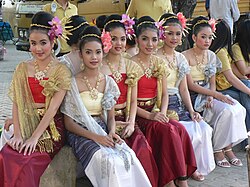User:Belfras/Sandbox10: Difference between revisions
No edit summary |
|||
| Line 159: | Line 159: | ||
== Culture == | == Culture == | ||
<small>This section includes participation of other members of Ajax that has not yet been confirmed or sought out and is, therefore, to be considered WIP and to-be-confirmed.</small> | |||
[[File:Thai traditional costumes Chiang Mai 2005 033.jpg|250px|thumbnail|left|Ankati women wearing Kunu (<small>කුණු</small>) traditional dress.]] | |||
The national culture of Ankat has evolved greatly over time, from it's isolationism whilst ruled over by it's monarchy during the Walpoli era, to the rapid influx of trade and immigrants after [[Mutul|Mutulese conquest of Ankat]]. Following the withdrawal of Mutulese imperialism in XXXX, the Ankat Republic of the Attunippi era absorbed influences from all over Ochran and some from western Scipia. Strong [[Tsurushima|Tsurushimese]], [[Fahran|Fahrani]], [[Mutul|Mutulese]], and other influences are still evident in traditional and modern Ankati culture. Modernisation brought in by traders from [[Oxidentale]], [[Norumbria]], and chiefly [[Belisaria]] played a significant role in shaping it's modern culture. | |||
Modern culture of Ankat is in itself considered a wholly different animal to the traditional cultural ways and methods, sometimes differentiated in being named the Terasi culture. The origin of the modern culture can be traced to the socialist reformation of government in 1948, with the first government adopting Belisarian trends of nationalism and industrialisation that also brought with it sweeping agricultural and transportation improvements throughout the nation. Sweeping reforms enacted throughout this period and the after-effects of the Attunippi era has also had lasting impacts on the nation's primary religion, [[Margaya]] | |||
. | |||
{{clear}} | |||
=== Literature === | === Literature === | ||
=== Religion === | === Religion === | ||
{{main|Margaya}} | |||
Margaya (<small>මාර්ගය, lit. 'The Way'</small>) | |||
=== Cuisine === | === Cuisine === | ||
Revision as of 16:14, 10 April 2020
Socialist Republic of Ankat අන්කට් සමාජවාදී ජනරජය (Terasi) ankaṭ samājavādī janarajaya | |
|---|---|
| Motto: ටෙරාස් කෝල්ගේ ආලෝකයෙන් අපි නැගී සිටිමු "ṭerās kōlgē ālōkayen api nægī siṭimu" "In the light of Teras Kol we stand" | |
| Anthem:
අපි ඔහුගේ ප්රතිරූපය තුළ වැඩ කරමු "api ohugē pratirūpaya tuḷa væḍa karamu" "We work in his image" | |
| Capital and | Nilagne Naegima |
| Official languages | Terasi |
| Demonym(s) | Ankati |
| Government | Unitary one-party socialist republic |
| Suneshka Iriyagolla | |
| Eshan Silva | |
| Samithra Malinga | |
| Legislature | National Assembly |
| Formation | |
| Population | |
• 2019? estimate | 103,235,813? |
• 2013? census | 99,895,720? |
| GDP (PPP) | 2019? estimate |
• Total | $2.374 trillion? |
• Per capita | $23,000? |
| Currency | Tepsi (TP/В₽) |
| Date format | dd.mm.yyyy |
| Driving side | left |
| Calling code | +69420 |
| ISO 3166 code | ANK |
| Internet TLD | .msv |
Ankat (Terasi: අන්කට්), officially the Socialist Republic of Ankat (Terasi: අන්කට් සමාජවාදී ජනරජය)
History
Geography
Climate
Government and politics
Foreign relations
Military
The Ankati Armed Forces was created as part of the sweeping overhauls following the revolution of 1948. It had previously been known as the Ibid Freedom Army (IFA) and from 1904 till 1945 had been pushed into guerrilla warfare by the military of the old regime. The Armed Forces consists of the Army, Navy, and the Air Force. The Navy operates the nation's coast guard as part of it's Naval Auxiliary.
The Socialist Republic operates a national service, and every male and female has to serve at least three years in the Armed Forces from the age of 16 to 22, those who try to avoid national service are typically subjected to jail terms. The professional service of the military is voluntary in peace-time, and typically offers more than what most Ankati would encounter in civilian life.
Administrative divisions
Human rights issues
Economy
Agriculture
Science and technology
Infrastructure
Transport
Demographics
Culture
This section includes participation of other members of Ajax that has not yet been confirmed or sought out and is, therefore, to be considered WIP and to-be-confirmed.
The national culture of Ankat has evolved greatly over time, from it's isolationism whilst ruled over by it's monarchy during the Walpoli era, to the rapid influx of trade and immigrants after Mutulese conquest of Ankat. Following the withdrawal of Mutulese imperialism in XXXX, the Ankat Republic of the Attunippi era absorbed influences from all over Ochran and some from western Scipia. Strong Tsurushimese, Fahrani, Mutulese, and other influences are still evident in traditional and modern Ankati culture. Modernisation brought in by traders from Oxidentale, Norumbria, and chiefly Belisaria played a significant role in shaping it's modern culture.
Modern culture of Ankat is in itself considered a wholly different animal to the traditional cultural ways and methods, sometimes differentiated in being named the Terasi culture. The origin of the modern culture can be traced to the socialist reformation of government in 1948, with the first government adopting Belisarian trends of nationalism and industrialisation that also brought with it sweeping agricultural and transportation improvements throughout the nation. Sweeping reforms enacted throughout this period and the after-effects of the Attunippi era has also had lasting impacts on the nation's primary religion, Margaya .
Literature
Religion
Margaya (මාර්ගය, lit. 'The Way')



